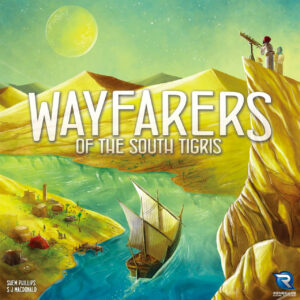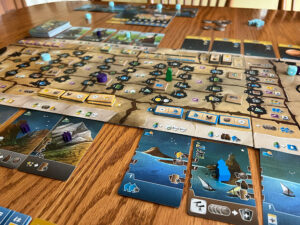 I am a sucker for Garphill Games…games. I have reviewed the expansions for both Architects of the West Kingdom and Viscounts West Kingdom as well as Circadians: First Light. I have not reviewed but own all of Raiders of the North Sea as well as Paladins of the West Kingdom. I am obviously a huge fan!
I am a sucker for Garphill Games…games. I have reviewed the expansions for both Architects of the West Kingdom and Viscounts West Kingdom as well as Circadians: First Light. I have not reviewed but own all of Raiders of the North Sea as well as Paladins of the West Kingdom. I am obviously a huge fan!
Needless to say, when Tony received a review copy of Wayfarers of the South Tigris, I jumped at the opportunity. Is it worthy enough to remain in my collection or should it jump in a lake…err, river?
Gameplay Overview:
Wayfarers of the South Tigris is a <takes a deep breath> worker placement, dice placement, tile placement, set collection, and influence majority game <almost passes out> for one to four players. Games take approximately one to two hours, depending on player count and game experience. It takes up a considerable amount of table space, especially at higher player counts and as tableaus expand.
The game is made up of a variable number of turns, with each player performing one available action on their turn:
Place a die – dice are placed on either a player’s caravan or cards already owned to generate assets
Place a worker – workers are placed on unacquired cards surrounding the board to activate the action in the cards slot on the board
Rest – if the player has one or no dice in their supply, they can take a Journaling action, then they move ALL dice to their supply and reroll them
The game ends when the first player reaches the end of the Journal track. Points are calculated and the player with the most points win the game.

Game Experience:
So how was my experience with Wayfarer? I was torn. I loved some aspects of the game, but a couple of design choices left me scratching my head.
What made me love the South Tigris
If you are looking for a Euro with numerous options, Wayfarers may be for you. Looking at the description above, it does not seem like that many—you can “only” either place a worker, place a die, or rest. It is the number of options within these as well as the timing of when to do each action that is the bread and butter of Wayfarers.
Let’s start with placing a die. Your player board and its included caravan determine what actions you can take with your dice. The die face placed will earn the assets and other options located in the column matching its face. You can then place the die in a slot that matches the asset(s) earned. Dice placement locations include the default spaces included on your player board at the start of the game as well as from water and land cards acquired during the game with dice placement spaces. The die face MUST earn the asset(s) required for the space you wish to utilize.

To make dice placement easier, your caravan can be altered by acquiring upgrade tiles and placing them in your caravan. It is a simple polyomino puzzle in which you will be focusing on maximizing what upgrades are in which die face column. This will add asset(s) available to a die face, as well as other abilities, like earning Silver or removing costs. Finally, if you are utilizing a dice placement space on a water or land card, Townsfolk cards acquired in previous turns that are tucked under that card will provide additional benefits.
Needless to say, Wayfarers takes the normally simple action of placing a die and turns it into a mini game of its own. It feels like a sandbox die placement game as you can modify not only the outputs of the die face through the caravan, but the benefits received via your townsfolk cards. Your appreciation of the openness in design will determine your enjoyment of Wayfarers.
Like the die placement action, placing workers in Wayfarers is not like it is in most board games. First, worker colors determine what a worker can do, not who owns them (think Raiders of the North Sea). Second, they are placed on the cards around the board and activate the action of the slot the card is in. Third, if you acquire a card with a worker on it, you get the worker. I enjoyed this spin on worker placement. Similar to Raiders, you must balance the need for the action vs. giving your opponent a valuable worker if they purchase the card before you can. I also liked that this action gave you a reliable method of acquiring resources or actions. This is a nice balance compared to the potential randomness of the dice rolls. Also, because of the way workers are acquired during the game, some players can have one or no workers while other have many.

Unsurprisingly, the resting option has several parts to it. It is not simply “clear your spaces and collect your workers.” Well, it DOES clear your dice and allow you to reroll them to use in your next turn; however, you do not get any workers since no one owns a specific color. You can also collect resources when you rest. The most important aspect of resting is Journaling. You can only move your player marker across the board by Journaling, which is done when resting. When moving across the board, you gain the bonus(es) in the space you move to. After your first move, future moves have requirements that must be met to move to the next space, be it specific tags or cards or influence. What I loved about the Resting action is not only that it is more than your basic clean up action, but that many of the actions, including the basic Journaling action on your player board, require you to have one or zero unplayed dice in your supply. This prevents players from doing one or two simple actions, resting, and repeating.
Influence is a new mechanism introduced in Wayfarers that Garphill has stated will be included in all games in the South Tigris line. Influence allows you to place your influence markers in one of three guilds. You use your standing in guilds to meet Journal requirements. Having the most influence in a guild will provide end game scoring. You can also discard influence from a guild for one-time bonuses.
What made me wish I was playing a different Garphill game
Unlike previous Garphill games, Wayfarer did not feel elegant to me. It felt like several design choices had just one too many options tacked on or were not needed:

I loved the idea of the caravan and building the power of each die face but needing to not only consider which column you need your die to end up in (you may have rolled a 5 and want a 3) as well as the impacts of Townsfolk cards seemed a bit too much.
Five different card types felt like a lot, but determining their actual costs was more complicated than most games. There is the cost of the action to acquire the cards, except for land and water cards, which cost only the cost of the action. Townsfolk cards have an additional fixed Silver cost printed on the card, while Space cards Silver costs are based on the slot they are in. Inspiration cards are earned via Journaling. Again, this seemed like a lot.
I enjoy games designed with Tags (Terraforming Mars, Ark Nova), but they seem overcomplicated in this game. There are eleven Tags in total. Four of them are considered “primary” tags and are used for scoring both unique sets for having multiple of the same type. These four tags, along with two others, are also used to determine if you can tuck a Townsfolk card. If your display does not include the required Tags for a Townsfolk card, it cannot be acquired. Finally, they are also needed for meeting Journaling requirements, which complicated Journaling, especially at lower player counts (more on this is a bit)

I also did not like the way you could get “trapped” when Journaling. You cannot move unless you meet the requirements of the space(s) adjacent to your current space. I understand that part of the game is planning for this, but there is randomness in card draws and dice rolls, and what looks like an attainable goal mid-game may not come to fruition and you can be stuck for several turns trying to ear the requirements needed to continue Journal progress. I understand moving all the way across the board is not required to win, but it is the end-game trigger. SOMEONE must make it to the end. In addition, card turnover is lower at smaller player counts. This makes even having the Tags you need appear in the available cards less likely than at higher player counts.
Final Thoughts:
Wayfarers of the South Tigris was a difficult game for me to review. The sheer number of options presented in such simple actions (place a die, place a worker, rest) is a sign of a good design. But what kept it from being great is that it is not elegant, which is what Garphill game designs have been known for. Yes, they have become more complicated over the years (compare Paladins with all expansions to Raiders of the North Sea with all expansions), but this seems almost overdesigned. I know that the reception of this game has been great, and I can understand why—the sandbox like nature of building your engine is unique. Unfortunately, while I liked Wayfarers, it would be my least recommended Garphill game.
Final Score: 3 Stars – A unique Euro that is overly complicated
 Hits:
Hits:
• SO many options, almost a “sandbox” Euro
• New influence mechanism is excellent
• Significant replay value
Misses:
• Unnecessarily complicated
• Journal Track can be punishing
• AP prone players will drag the game out





















